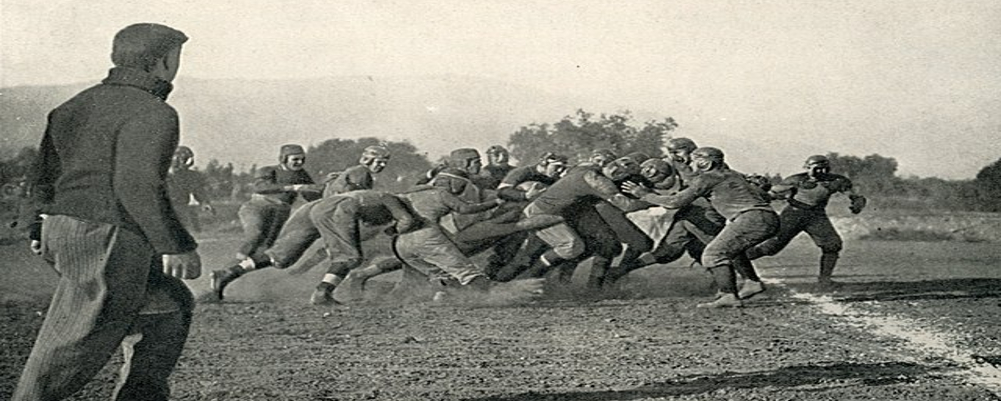In the video, Tim discusses how college football players have been getting paid under the table for many years. He mentions that in 1929, the Carnegie Foundation issued a report criticizing the underground payment system, but it was largely ignored due to the Great Depression.
This video is a fascinating look at the history of paying college football players. It is clear that this is a complex issue with a long history and that there are many different opinions on the matter.
Transcribed conversation with Timothy Brown on Paid College Players over a century ago
Hello, my football friends! Welcome again to The Pig Pen, your portal to positive football history. It is Tuesday, and we are happy to say that Timothy P. Brown of FootballArcheology.com has joined us again to talk about another of his great tidbits. Tim, welcome back to The Pig Pen.
Darin, thank you. It was good to see you again, hear your voice, and have the opportunity to chat a little bit. Yeah, this is, you know, the football seasons are winding down in all leagues here.
This is this coming weekend. We have the Super Bowl coming up. You know, we're actually recording a couple of weeks ahead of time, but we know who the participants are. And, you know, it's not so good for your neck of the woods. You know, the Lions had a great season and just didn't work out their way at the end of the game of the NFC Championship.
Unfortunately, I grew up a Packers fan, and they bit us the week before, and then the Lions. So I don't know that I really care anymore about either team that's in there. Sometimes, that's what makes it fun.
If you have no vested interest in it, you just sit back and hope for good football and enjoy the athletes, some of the great things they do, and what happens. And, you know, you're not worried one way or the other if something bad happens. Yeah.
Yeah. My daughter, who grew up in Detroit
but lives in San Francisco, kind of couldn't lose in that game. So, hopefully, she's got a continued rooting interest, but not for me.
Yeah. What are you going to do? Well, paying players—you know, these players in the NFL are getting paid quite a bit, and it sort of segues into what we're going to be talking about now. We know that college players are getting paid with the NIL contracts and everything, but you have a story in one of your tidbits from a little while back where you talk about some players getting paid in college almost a hundred years ago.
And maybe you'd like to discuss that with us today. Yeah. Well, you know, I think it, the idea of paying somebody to participate in sports, particularly at the college level, I mean, that's as old as people, you know, from the day that people said, hey, it's important for my college to be your college.
From that moment, they started finding ways to ensure that good athletes attended this school or that school. You know, and for a long time, it was an informal process. You know, there used to be a banker in town who would send, you know, pay for a kid to college.
And geez, if he happened to be a good athlete and went to Old State U, that was great. But, you know, they, you know, they're also like way back in the day, you know, top student-athletes often were like, they'd be like agents for cigar manufacturers or chewing gum manufacturer, you know, any, anything that was sold on campus. And then if they could influence people's buying behavior, you know, they got paid money, you know, for that kind of thing.
And there's a lot of that kind of stuff going on. And then, obviously, there were the easier no-show jobs that guys had. But so, I mean, there's always been kind of the under-the-table thing.
And then, in 1929, there was a big report. The Carnegie Foundation, you know, reported on college football, basically criticizing all of this underground payment, you know, system and, you know, having guys there who maybe weren't the greatest students, et cetera. And so the one, the funny thing about that, I mean, it was one of those things that kind of just ignored.
I mean, the Great Depression started shortly after they issued the report. So people kind of had, you know, bigger problems too, you know, to worry about. But there were, you know, a handful of people, professors, you know, folks directly involved in athletics who were kind of saying, we should pay these guys, you know, they should get a percentage of the gate or, you know, they should get, there was a guy at Missouri who said, you know, the players should get $2 per hour for practice.
Now, that doesn't sound like much, but it'd be the same as $36 an hour today, you know, beer money, you know, for a college athlete. And then there were a couple of student newspapers, Minnesota and UCLA, that came out saying, hey, you know, the football players in particular, they subsidize all other sports, which was true at most bigger schools at the time. And I've, you know, I've got documentation on that that I'll probably put out in another tidbit.
But so anyways, you know, and then others were just arguing like, you know, football in particular, and then later on basketball and baseball, they had, they were commercialized, you know, they were professionalized in every way other than paying the players. The coaches got big-time money, and people had to pay money to attend the games. And, you know, then they started selling video rights, and then they started selling TV rights.
So, you know, there were these pots and pots of money. So, if you look at a big-time college athletic program, that is a pro program. You know, it's run by professionals.
In some ways, it's run for professionals, right? And the only thing that wasn't professional about it was that the athletes didn't get paid. They got a scholarship, you know, at bigger schools, and then eventually they'd get some spending money and, you know, dah, dah, dah. But nothing like what their actual market, you know, power was.
And so now that this NIL is out there, you know, all of a sudden, guys are, you know, starting to make some pretty good money. Some guys are better off staying in college an extra year than signing some, you know, low-level rookie contracts. Now, then their pro contract, that clock starts, you know, doesn't start clicking or, you know, ticking for another year.
But, you know, somebody tells me I can make whatever, a million bucks through NIL, you know, versus, you know, whatever, you know, 800,000 or whatever the current rookie contract is worth, you know, you got to think about. So, it's just really, um, it's been a long time coming, right? And like myself, I don't necessarily like some of the things that are going to, the impact it will have on the game. But that's just selfishness, you know, whereas the kids deserve the money, you know, just like artists or, you know, musicians, or a kid who invents, you know, writes a piece of software or whatever, you know, TikTok sort of influencer, whatever, you know.
Anyway, it's one of those funny things. It's that conflict that has always existed, but now it's more or less out in the open.
So I think that's good. Yeah. Cause, uh, I mean, if it wasn't for the student-athletes, people wouldn't be paying to go watch an empty football field or basketball court or whatever event they're going to.
So yeah, those kids deserve it, and they work hard. And, uh, you know, I was kind of surprised though. You know, I knew when the NIL was coming out that, uh, you know, players were going to be getting paid, but I had no idea there was going to be as lucrative for, for some of these folks as it is in the, uh, I was astounded the LSU gymnast.
Uh, and I forget what her name is. She's on a couple of commercials now and is a social influencer. She's making millions, uh, just by her likeness and image.
So it's amazing. Yeah. And, you know, some people will get that money based on, frankly, what they look like, right?
Uh, others, you know, their personality, just their, you know, obviously she had to be smart enough to, I mean, she's a very attractive young lady. Still, you know, she figured out the game and, uh, was doing some, you know, you know, she, she's, you know, I mean, I've never watched herself, but I assume she's got to have a presence and delivery, whatever it is. Right. Um, she was so smart enough to take advantage of that and the situation she was in.
So yeah, more power to her. Yeah. He has a couple of extra bucks left over after buying the school books each semester.
That's for sure. Yeah. She didn't even have to sell her school books in the old days.
Great. Well, that's, I mean, that's interesting that it's been around that long that, uh, you know, the debate's been long for a hundred years now. So that's, uh, it's incredible.
That's why it's such a great read. And maybe you could share with the listeners how they, too, could partake in your tidbits. Yeah.
You can subscribe on Substack or visit footballarchaeology.com whenever you want. You can also follow me on Twitter, so whatever fits your fancy.
Well, Tim, we really appreciate you coming here and sharing another one of these great stories of football and aspects of football of, of old that, uh, you know, really have big meaning in today's college football world. And, uh, we appreciate you, and, uh, folks, make sure you check out FootballArchaeology.com. We have the links in the show notes to this tidbit, and it takes you into Tim's realm of FootballArchaeology.com, which you talked about. And Tim, we would love to talk to you again next week about another aspect of football.
Very good. Look forward to chatting again.


